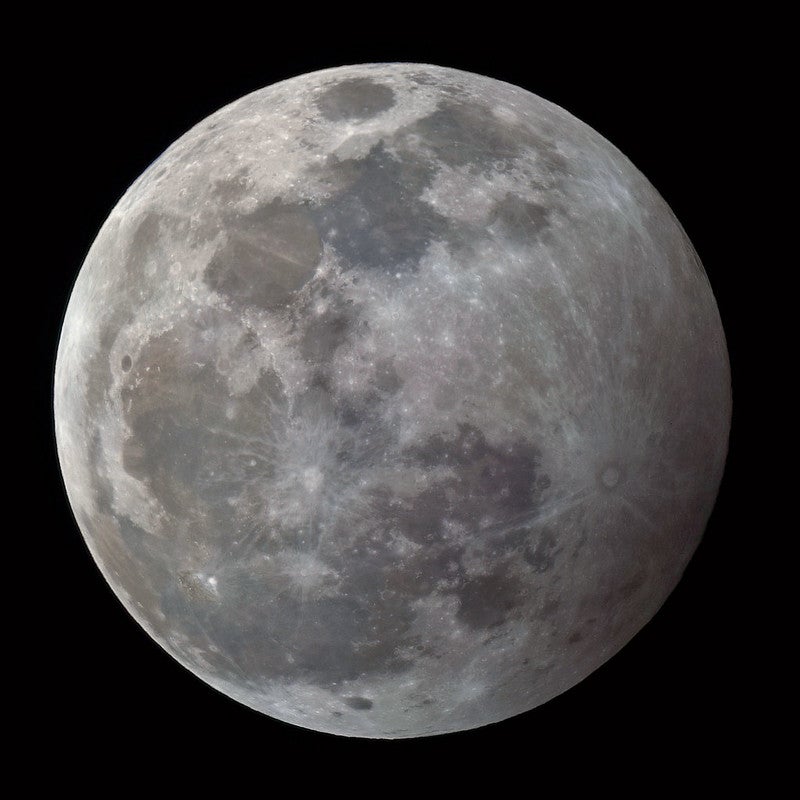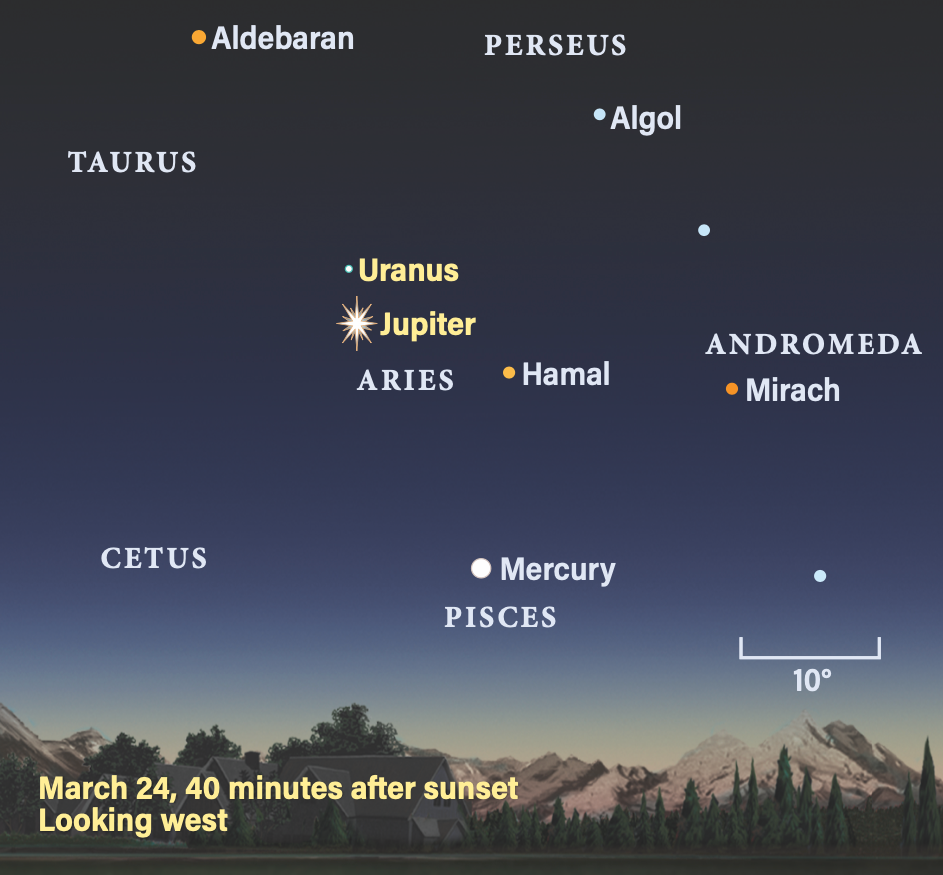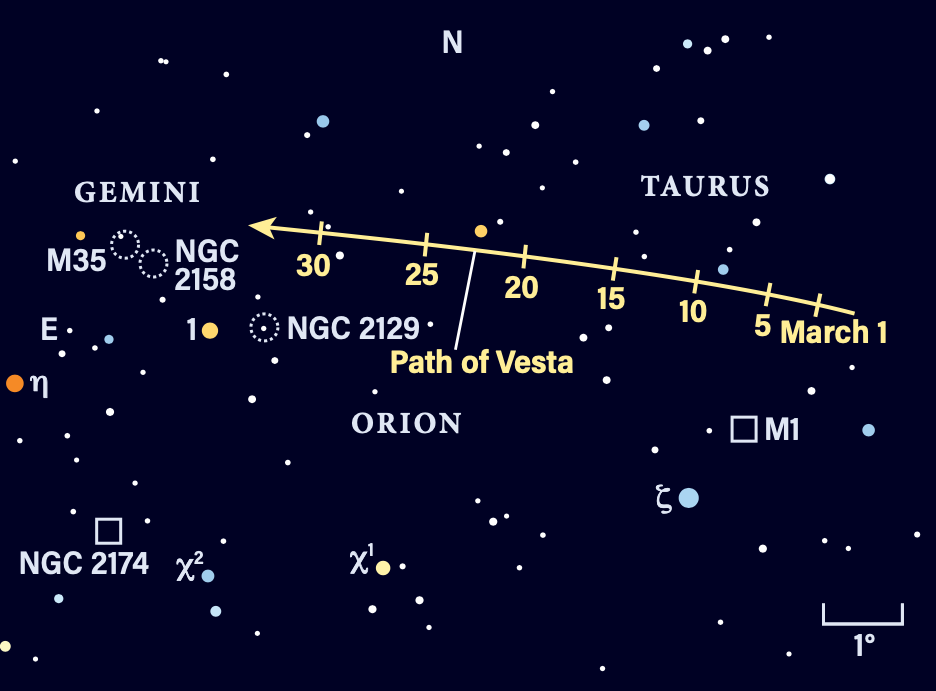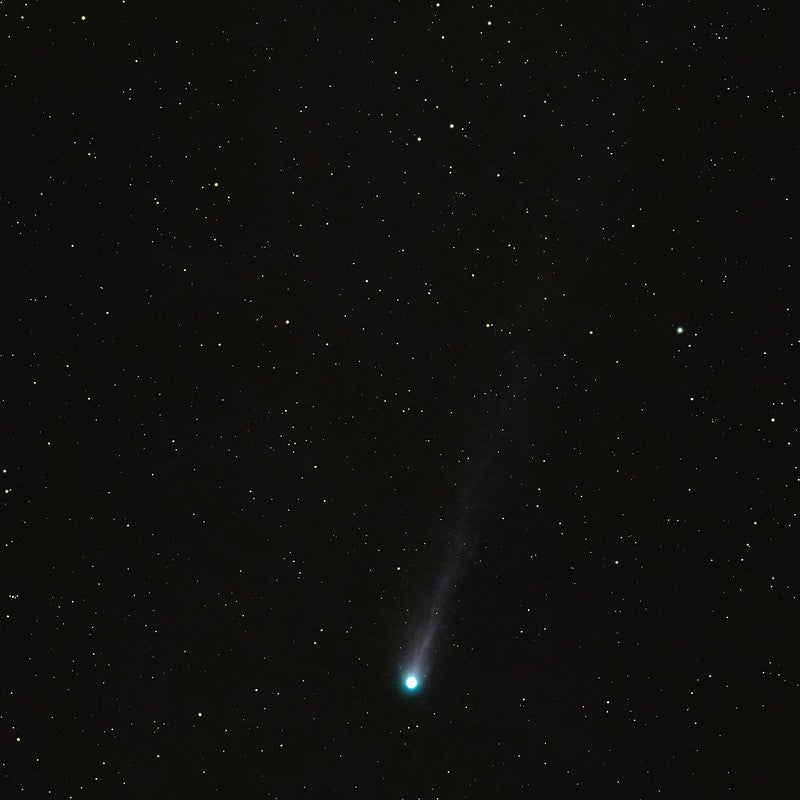
Friday, March 22
Spring’s premier globular cluster, M3, is on display in the constellation Canes Venatici this evening.
Not sure where that is? No problem! This somewhat lesser-known star pattern lies just behind Ursa Major, below the curving handle of the Big Dipper. And M3 has an easy signpost early tonight: It stands 12° above the bright star Arcturus in Boötes as the region is rising in the east around 9 P.M. local daylight time.
Note that as the night progresses, M3’s position will “tilt” relative to Arcturus until the cluster lies more to the upper left of the star. That’s because Ursa Major and Canes Venatici are circumpolar constellations, circling the North Celestial Pole instead of rising in the east and setting in the west. In absolute terms, M3 is 12° northwest of Arcturus, so as long as you can determine your celestial directions, you can always find it.
M3 is easy to view through binoculars or any telescope. Glowing at magnitude 6.2, this ancient cluster of stars spans about 18′ on the sky. Its dense core may appear almost solid, while the outskirts will seem to dissolve into countless stars, particularly at higher magnifications. In total, the cluster holds some half a million stars, many of which are variable. In physical space, it spans some 180 light-years.
Sunrise: 6:59 A.M.
Sunset: 7:15 P.M.
Moonrise: 4:56 P.M.
Moonset: 6:07 A.M.
Moon Phase: Waxing gibbous (94%)
*Times for sunrise, sunset, moonrise, and moonset are given in local time from 40° N 90° W. The Moon’s illumination is given at 12 P.M. local time from the same location.
Saturday, March 23
The Moon reaches apogee, the farthest point from Earth in its orbit, at 11:45 A.M. EDT, when it will sit 252,460 miles (406,295 kilometers) away.
Our satellite is now in Leo, located to the lower right of the 2nd-mangitude star Denebola, which marks the tip of the Lion’s tail. The constellation is already high in the east by 9 P.M. local daylight time. To the Moon’s upper right, as part of the Sickle asterism that looks like a backwards question mark, lies Algieba (Gamma [γ] Leonis), a magnitude 2 double star whose components are just under 5″ apart and can be split in most backyard instruments.
Those components have just over a magnitude in difference between them, shining at magnitude 2.3 and 3.6. Take a close look at their colors — the brighter star should appear slightly more orange, while the dimmer is a bit more yellow-hued. The two stars take an estimated 510 years to orbit each other, and the brighter star, cataloged as Gamma1 Leo, hosts a gas giant planet nearly 9 times the mass of Jupiter.
Sunrise: 6:58 A.M.
Sunset: 7:16 P.M.
Moonrise: 5:56 P.M.
Moonset: 6:28 A.M.
Moon Phase: Waxing gibbous (98%)

Sunday, March 24
Mercury reaches its greatest eastern elongation from the Sun, standing 19° from our star at 7 P.M. EDT.
The tiny planet remains visible for more than an hour after sunset. Glowing at magnitude –0.3, you can find it still 12° high 30 minutes after sunset, a bright point of light hanging above the western horizon. Through a telescope, Mercury spans 8″ and appears some 42 percent lit.
To Mercury’s upper left in the sky is brighter Jupiter, shining at magnitude –2.1. The giant planet sets roughly an hour after Mercury, affording you longer to view it and its Galilean moons. All four of these moons lie east of the planet early in the evening, and their positions change depending on when they are viewed.
At sunset in the eastern half of the country, Io lies closest to Jupiter’s eastern limb, with Europa just beyond it. Then comes Ganymede and, much farther east, Callisto. But around 8:50 P.M. EDT, Io and Europa pass, with Io continuing eastward away from the planet and Europa moving west, now closest to the eastern limb. Around 10:25 P.M. CDT, when Jupiter is quite low in the Midwest and after it has set on the East Coast, Europa crosses in front of the cloud tops in a transit. Its shadow will follow just under two hours later, after the gas giant has set for the continental U.S.
Sunrise: 6:56 A.M.
Sunset: 7:17 P.M.
Moonrise: 6:55 P.M.
Moonset: 6:48 A.M.
Moon Phase: Full
Monday, March 25
Full Moon occurs at 3 A.M. EDT, bringing March’s Worm Moon to the sky. The Moon is now in Virgo, close to the magnitude 2.7 double star Porrima (Gamma Virginis).
This is the last Full Moon before the upcoming April 8 total solar eclipse, which will occur when the Moon is New. And this Full Moon will undergo an eclipse of its own as a penumbral lunar eclipse takes place early this morning, beginning shortly before 1 A.M. EDT (note this is late on the 24th for time zones farther west) and ending around 5:30 A.M. EDT, lasting a total of 4 hours and 39 minutes. Greatest eclipse occurs at 3:14 A.M. EDT.
A penumbral lunar eclipse occurs when the Moon passes through the penumbra — the dimmer, outermost region of Earth’s shadow. The effect is quite subtle, even though most of the Moon will pass through the penumbra, with just a small portion of the northeastern limb clearing the shadow entirely. Only careful observers may notice the Full Moon’s light appear to dim slightly, or perhaps change subtly in hue to a more brownish color. For the best chance of observing this effect, look at the Moon early in the eclipse and then again around the time of maximum eclipse to see if you can note a difference. Such events are also great opportunities for astrophotographers as well.
Sunrise: 6:54 A.M.
Sunset: 7:18 P.M.
Moonrise: 7:55 P.M.
Moonset: 7:07 A.M.
Moon Phase: Full
Tuesday, March 26
With a nearly Full Moon still in the sky, we’re limited to bright astronomical targets for the next few nights. Tonight’s target may further be limited to observers at low latitudes, as it lies in the constellation Lupus, which can be difficult or impossible to see if you live too far north.
If you can see Lupus, then give this open cluster a try: NGC 5822 is a bright, young group of stars with a total magnitude of 6.5. Under good, dark skies, it’s visible to the naked eye, but tonight you’ll want binoculars or a telescope to help you find it amid the Moon’s bright light. The cluster, which spans about 35′, sits just 2.6° southwest of magnitude 3.4 Zeta (ζ) Lupi, offering an easy jumping-off point from that star. And at least 50 stars should be visible in a small telescope with only modest magnification.
Despite a magnitude on par with many Messier objects, this cluster is not in that catalog because of its position — it is not visible from Paris, where Messier scanned the skies.
Sunrise: 6:53 A.M.
Sunset: 7:19 P.M.
Moonrise: 8:55 P.M.
Moonset: 7:27 A.M.
Moon Phase: Waning gibbous (98%)

Wednesday, March 27
The 8th-magnitude glow of asteroid 4 Vesta sits just off the feet of Gemini tonight. The main-belt world is passing near the open cluster NGC 2129 for the next few days, approaching two more open clusters: NGC 2158 and M35.
Start by looking west after sunset and locating Betelgeuse, the bright red giant star that marks one of Orion the Hunter’s shoulders. To the upper right of this star lies the constellation Gemini. Vesta is some 5° west-northwest of Propus tonight, a star also cataloged as Eta (η) Geminorum and which glows at magnitude 3.3.
Magnitude 6.7 NGC 2129 lies just under 2° southeast of Vesta tonight, while magnitude 8.6 NGC 2158 is 3° to Vesta’s east. And just 0.3° farther east of NGC 2158 is magnitude 5.3 M35, which spans roughly half a degree and holds about 500 stars. This last cluster is the easiest to view, while fainter NGC 2158 may need a larger aperture to capture.
If you’re able, check out this region of sky again and again for the next few nights to watch how Vesta is moving in relation to the latter two clusters, the tiny point of light approaching them as each day passes.
Sunrise: 6:51 A.M.
Sunset: 7:20 P.M.
Moonrise: 9:58 P.M.
Moonset: 7:48 A.M.
Moon Phase: Waning gibbous (95%)
Thursday, March 28
Uranus now lies 2.2° due south (to the lower left) of magnitude 4.3 Botein, Aries’ delta star. The ice giant also hangs about 1.3° below (southwest of) the Pleiades in Taurus, as well as sits just 4° northeast of Jupiter. Use the gas giant, bright and easy to spot in the west after sunset, to slide over to Uranus’ location.
Uranus’ disk spans just 3″ on the sky, a testament to its great distance from Earth — some 20.3 times the average Earth-Sun separation. It should look a bit like a “flat,” gray-hued star, just southeast of a line drawn between Jupiter and Botein. Binoculars should readily pick it up, as will a small scope.
While you’re in the area, make sure to revisit Jupiter, whose Galilean moons are again on display — and on the move. Early in the evening, Io stands alone to the east; over time, it approaches the planet for a transit overnight, after Jupiter has set for most observers. Meanwhile, Ganymede passes Europa around 9:20 P.M. EDT, with the former moving east as the latter moves west. Callisto lies farthest west. Ganymede will undergo an occultation early tomorrow morning, again after the planet has set for U.S. observers.
Jupiter’s Great Red Spot will be visible as well, transiting the central meridian of the planet around 9:30 P.M. EDT.
Sunrise: 6:49 A.M.
Sunset: 7:21 P.M.
Moonrise: 11:03 P.M.
Moonset: 8:12 A.M.
Moon Phase: Waning gibbous (90%)

Friday, March 29
Comet 12P/Pons-Brooks, also called the Devil Comet, is approaching Aries’ alpha star, Hamal. Now just 1.5° northwest of the star, Pons-Brooks was recently recorded around 5th magnitude, making it an ever-easier target to spot in the evening sky. Start observing shortly after the Sun goes down, as the twilight begins to deepen. Once 2nd-magnitude Hamal appears, scan nearby with binoculars or a telescope until you land on Pons-Brooks.
Recent photographs have shown its distinct green color and long, thin tail, though you may not see these characteristics visually. Instead, the comet may look like a small, fairly compact fuzzball. Pons-Brooks is closing in on the Sun and will pass closest to our star later in the month — after standing in the sky near the eclipsed Sun on April 8. Astronomers are eagerly watching to see how much it may brighten before that date, as Pons-Brooks is well known for the occasional outburst, which can quickly bump up its magnitude.
The comet will pass even closer to Hamal tomorrow, skimming within 0.5° of the star, so we’ll highlight that meetup in our column next week.
Sunrise: 6:48 A.M.
Sunset: 7:22 P.M.
Moonrise: —
Moonset: 8:41 A.M.
Moon Phase: Waning gibbous (83%)

Sky This Week is brought to you in part by Celestron.









